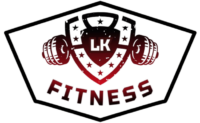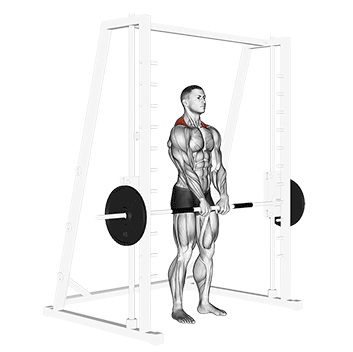Back Training Fundamentals
Build Strong & Wide Back, Fix Your Posture And Get Rid Of Lower Back Pain
Introduction
A well-developed back is the cornerstone of a strong, balanced physique. It supports nearly every movement and plays a crucial role in maintaining good posture, reducing the risk of injuries, and enhancing overall athletic performance. In this guide, we’ll explore the best exercises that will help you build a thick and wide back, as well as strength, improve functionality, and minimize pain.
Before we proceed with the guide it’s important to understand the anatomy of the back, the types & functionalities of the back muscles. The back has a total of 20 different muscle groups, but we’ll focus on the main ones: Latissimus Dorsi (Lats), Teres Minor & Teres Major, Trapezius (Traps), Rhomboid Minor & Rhomboid Major, and Spinal Erectors (Mid & lower back). Despite being a part of the back, we’ll cover Read Deltoids in the Shoulder Training Guide.
 Let’s build that V taper!
Let’s build that V taper!
The Best Guide For Building Thickness & Width To Your Back
Effective Back Exercises
1. Pullups / Chinups – Great For Building Wide Back. Primarily Targets
Lats, Teres Minor & Major. Also, Activates Rhomboids, Biceps & Forearms.


How To Do It:
- Hang from a pull-up bar with an overhand (pull-up) or underhand (chin-up) grip.
- Make sure your feet are in the air and you’re fully stretched out.
- Pull your body up until your chin is over the bar.
- Lower yourself back down into the starting position
- Perform 3 sets of 10-12 repetitions
Variations & Tips:
- Experiment with the grip style (Overhand, underhand, or neutral) and width. Stick with whatever makes you feel your back muscles the most.
- Do not swing your body to keep momentum down to a minimum, movement should be controlled throughout the exercise, straight up and straight down.
- No additional weight is required in the beginning, start with your own body weight and as you get stronger slowly add weight using belts or chains.
- If you’re struggling to pull yourself up without assistance use a chair to help you get into a high position. Firmly grip the bar, lift your feet off the chair, and slowly lower yourself down until your arms are fully extended. Aim for 3 sets of 5-6 repetitions.
- Assisted pull-up machine is an excellent alternative, make sure to use it if your gym has one.
2. Lat Pulldowns – Excellent For A Warm Up, Targets Same Muscles As Pullups / Chinups.
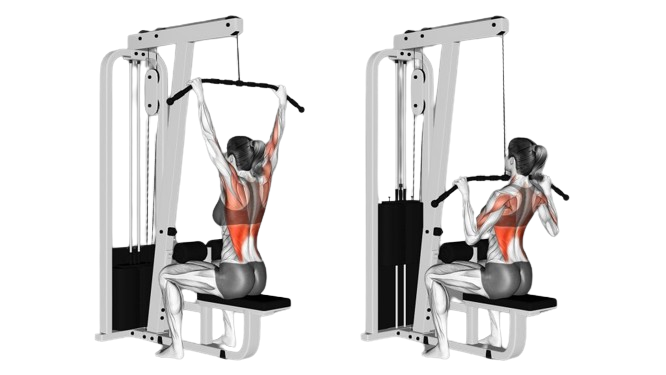
How To Do It:
- Attach the appropriate handle to the pulley and adjust the seat so your thighs fit comfortably under the thigh pad.
- Grab the bar with your hands shoulder-width apart, sit with your back straight and your legs secured under the thigh pad.
- Lean back slightly and pull the bar down towards your upper, focus on using your back muscles rather than your arms.
- At the bottom of the movement, squeeze your shoulder blades together and hold the contraction for a brief moment.
- Allow the bar to return to the starting position in a controlled manner, fully extending your arms while maintaining tension in your lats
- Perform 3-4 sets of 112-15 repetitions.
Variations & Tips:
- Lat pulldowns are a great way to start your back training session.
- Do not use momentum to pull the bar down. Do not lean back excessively, keep your body stationary.
- Experiment with different grip styles, handle attachments, and various machines that replicate the same movement.


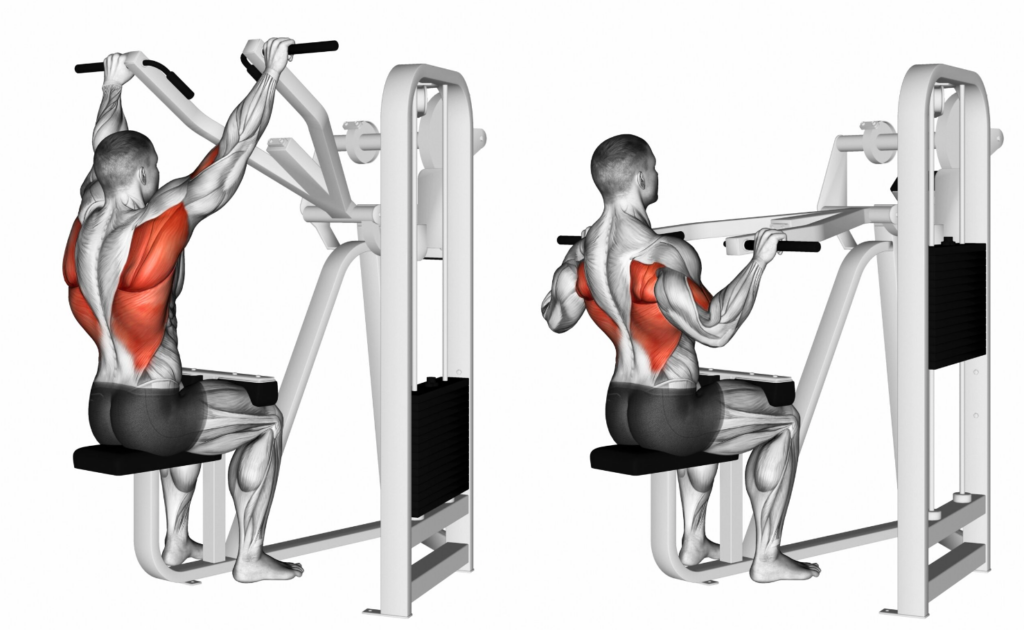
3. Barbell Bent Over Rows – Build Thick Back
Targets lats, traps, rhomboids, and spinal erectors. Indirectly stimulates biceps and forearms


How To Do It:
- Stand with your feet shoulder-width apart.
- Bend at the hips and knees to pick up the barbell with your hands slightly wider than shoulder-width apart.
- Keep your back straight, core engaged, and chest up. Bend at the hips until your torso is nearly parallel to the floor. Keep a slight bend in your knees.
- Pull the barbell towards your groin area. Focus on squeezing your shoulder blades together as you lift.
- Keep your elbows close to your body and pull them back as you lift the barbell.
- At the top of the movement, squeeze your back muscles and hold a contracted position for a brief moment.
- Slowly lower the barbell back to the starting position in a controlled manner, fully extending your arms.
- Perform 3-4 sets of 10-12 repetitions.
Variations & Tips:
- Make sure your hips and lower back are properly warmed up before performing this exercise.
- Feel free to experiment with the grip style (Overhand – palms facing back / Underhand – palms facing forward)
- Keep your body stationary throughout the movement.
- Do not use too much weight, it’ll lead to form breakdown.
- Do not round your back, it can lead to injury.
- If your grip is getting loose and the bar starts slipping out of your hands before your back muscles get tired – feel free to use wrist straps. Also, check out our forearm training guide to get a stronger grip.
4. Dumbbell Row – Excellent Alternative To Barbell Rows For Building A Thick Back


How To Do It:
- Grab the dumbbell with one hand, and place the opposite knee and hand on the bench for support.
- Keep your back straight, almost parallel to the floor, head up, and your core engaged.
- Pull the dumbbell towards your hip, keeping your elbow close to your body.
- At the top of the movement, your upper arm should be in line with your torso.
- Slowly lower the dumbbell back to the starting position in a controlled manner, fully extending your arm. You should feel your lat stretching.
- Perform 3-4 sets of 10-12 repetitions.
Variations & Tips:
- Similarly to Barbell Rows, do not use too much weight and do not round your back. The only moving parts of your body should be the arm holding the dumbbell and the corresponding shoulder.
- Always focus on pulling your shoulder back and squeezing your back at the top of the movement, rather than just lifting the weight up.
- If there is no free bench available, feel free to use a dumbbell rack or any surface with appropriate height which you can place your hand on for support. Leal over, bend your knees slightly, keep your lower back straight, and start rowing.
- Do not jerk the weight up, movement should be controlled throughout the exercise.
- You can use a flat or incline bench for chest support to perform dumbbell rows with both arms simultaneously to save time.


5. Cable / Machine Rows – Safe Way To Build Wide & Thick Back

How To Do It:
- Attach the handle of your choice to cable machine the pulley and set the appropriate weight.
- Sit on the bench, make sure your feet are secured and firmly pressed against the pads, and bend your knees slightly.
- Lean over, grab the handle, and lean back until your torso is perpendicular to the ground. This is your starting position
- Pull and bring the handle to your abdomen by pulling your shoulders back. Hold that position for a brief moment.
- Allow the handle to return to the starting position in a controlled manner, fully extending your arms while maintaining tension in your back muscles and keeping your torso stationary.
- Perform 3-4 sets of 10-12 repetitions.
Variations & Tips:
- There are numerous variations of this exercise, including different grips (wide, close, overhand, neutral, underhand), pulling angles, and trajectories. However, they all serve the same purpose: stretching and contracting your back muscles through horizontal pulling motions.
- Regardless of which variation of the exercise you’ll end up doing, remember – Do not use momentum and always focus on your back muscles instead of pulling the weight with your arms, imagine trying to fold your upper body in half by pulling your shoulders back together, that’s what horizontal rowing exercises should feel like.
- Experiment with different machines and angles. Stick to whichever makes you feel your back muscles the most, Here are some honorable mentions:
Wide Grip Cable Machine Row
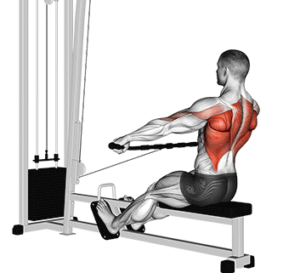

Chest Supported, Plate Loaded Machine Row

Seated Machine Row With Adjustable Weight Stack

6. Lever High Row – Another Great Exercise For Building Width And Thickness
This truly unique machine captures the best of both worlds: maximum vertical stretch at the top and effective horizontal contraction at the bottom.


How To Do It:
- Adjust the seat to a position that maximizes the stretch when your arms are fully extended.
- It’s highly advised to use an underhand grip (Palms facing up) but feel free to experiment with different grip styles.
- Sit on the machine seat with your chest against the pad, your feet flat on the floor, and your upper legs secured under the thigh pad.
- Pull the handles down and back. Squeeze your lats at the bottom and hold that contracted position for a brief moment.
- Allow the handles to raise back up to the starting position and fully extend your arms, you should feel the stretch right next to your armpits.
- Perform 3-4 sets of 10-12 repetitions.
Variations & Tips:
- You can do one arm at a time which allows for a better mind-muscle connection and better focus.
- Experiment with different grip styles to figure out what works best for you.
7. Dumbbell Pullovers – Build Massive Lats
Dumbell Pullover is a great back exercise that also targets chest and triceps.
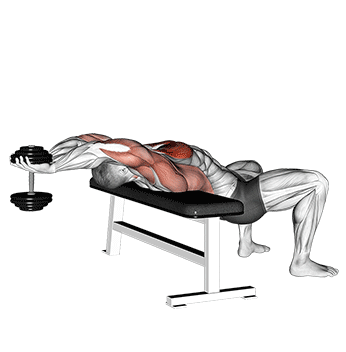

How To Do It:
- Lie on a flat bench with your head at one end and feet planted firmly on the floor.
- Grab the dumbbell with both hands, palms facing upward (Overhand grip). It’s helpful to have a friend who can hand you the dumbbell and take it away from you once you’re done.
- Extend your arms above your chest, keeping a slight bend in your elbows.
- Slowly lower the weight in an arc behind your head while maintaining a slight bend in your elbows.
- You should feel a stretch in your lats and chest as you lower the weight.
- Bring the weight back to the starting position using the same arc motion. Maintain the arm angle throughout the exercise.
- Perform 3 sets of 10-12 repetitions.
Variations & Tips:
- Make sure your shoulders are properly warmed up before you do this exercise.
- Ensure the weight does not go too far down behind your head to prevent strain.
- Feel free to use a machine that imitates the same movement if your gym has one.
Pullover Machine


8. Deadlifts – Build A Thick Back, Big Traps, Strong Legs And Improve Your Grip Strength
The deadlift is a fundamental exercise that targets multiple muscle groups, including the back, glutes, hamstrings, and core and improves grip strength. Here’s a step-by-step guide on how to perform a deadlift correctly with a focus on engaging the back muscles:
How To Do It:
- Stand with your feet shoulder-width apart, toes pointing slightly outward.
- Position the barbell over the middle of your feet, close to your shins.
- Keeping your lower back straight, hinge at hips and bend your knees to grasp the bar with your hands slightly wider than shoulder-width apart
- At this point, you should be locked in. Firm grip, arms fully extended, legs and core engaged with your back as straight as possible. This is your starting position.
- If you could look at yourself from the side, the shoulders, knees, and bar should be aligned with each other.
- Drive through your heels to lift the bar up. Keep the bar close to your body, moving in a straight line as you extend your hips and knees.
- Focus on engaging your back muscles by retracting your shoulder blades as you lift.
- Once the bar passes your knees, push your hips forward to stand up straight.
- Do not lean back too excessively. Keep your shoulders retracted and your back muscles engaged.
- Do not drop the bar down. Keep the lower back straight, and slowly reverse the movement by pushing your hips back and bending your knees, lowering the bar along the same path.
- Perform 3 sets of 10-12 repetitions.
Variations & Tips:
- You can use wrist straps if the bar starts to slip out of your hands. If available, use magnesium for a better grip. Check out our forearm training guide to improve grip strength.
- There are a couple of variations to this exercise, such: as Romanian/Stiff-legged deadlift, Trap-bar deadlift, Deficit deadlift, and Sumo deadlift. While most of them are considered lower-body exercises, Trap-bar deadlifts can be utilized in back training as well.
Trap-Bar Deadlift
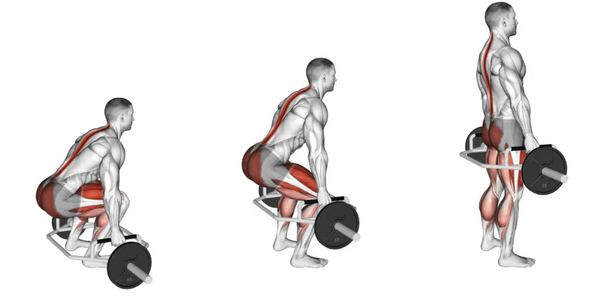
- Another great deadlift variation for the back specifically is a Rack-pull. Feel free to do that instead if you’re yet uncomfortable with deadlifting.
Rack Pulls

9. T-Bar Rows – The Back Mass Builder

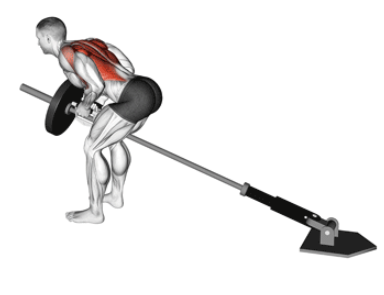
How To Do It:
- You’ll need a barbell with a landmine attachment and a V-handle or neutral grip attachment.
- If your gym doesn’t have a landmine attachment, you can stick the barbell in the corner and place a heavy object or a plate on top to keep it in place.
- Load the barbell with the desired weight, preferably using smaller circumference plates that allow you to pull the bar closer to your body.
- Stand over the bar with your feet shoulder-width apart. The bar should be between your legs.
- Lean forward and bend your knees to reach the handle, keeping your lower back straight.
- Keep your core engaged, shoulder blades retracted, and your torso at about 45% angle to the floor.
- Pull the handle towards your lower chest or upper abdomen by squeezing your shoulder blades together and bending your elbows.
- At the top of the movement, squeeze your back muscles and hold the contraction briefly.
- Slowly lower the weight back to the starting position in a controlled manner, fully extending your arms.
- Perform 3-4 sets of 10-12 repetitions.
Variations:
Chest Supported T-Bar Row Machine
- This machine allows you to use a grip of your choice (Overhand/underhand). With chest support, there is less stress on your lower back, allowing you to focus on proper execution without compromising form.
- You can modify this exercise by positioning your chest lower against the pad and aligning the handles with your shoulder level. Grip the handles with an overhand grip, flare out your elbows to form a T shape with your arms and torso, and pull the weight straight up. This will let you target your rear delts more, but we’ll cover that in the corresponding article.
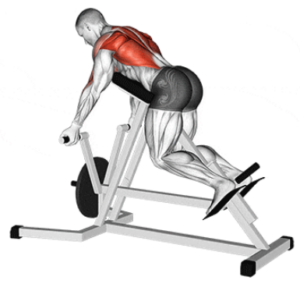
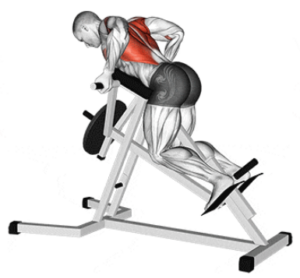
10. Shrugs – Build Massive Traps

How To Do It:
- Load the barbell with a manageable weight.
- Stand with your feet shoulder-width apart and grasp the barbell with an overhand grip (palms facing down), hands slightly wider than shoulder-width.
- Keep your back straight, core engaged, chest up and shoulders retracted.
- Lift your shoulders straight up towards your ears in a shrugging motion. Focus on using your trapezius muscles to lift the weight.
- At the top of the movement, hold the contraction for a brief moment to maximize muscle engagement.
- Slowly lower your shoulders back to the starting position in a controlled manner.
- Perform 3 sets of 12-15 repetitions.
Variations & Tips:
- Keep your arms straight, and avoid bending your elbows throughout the movement.
- Perform the exercise with a controlled motion, avoiding jerking or using momentum.
- Keep your neck in a neutral position, avoiding any forward or backward tilting.
- If the bar starts slipping out of your hands, feel free to use wrist straps. Make sure to check out our forearm training guide for improving your grip strength.
- There are numerous variations of this exercise, each equally effective. It ultimately comes down to which one helps you feel your traps the most. Experiment with different variations and stick to the one that works best for you.
Dumbbell Shrugs
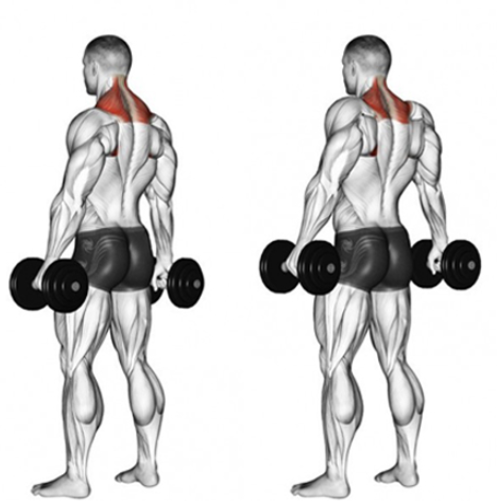
Smith-Machine Shrugs
Plate Loaded Shrug Machine

Conclusion
- In the 21st century, many of us spend the majority of our waking hours seated in front of screens, leading to lower back pain, neck pain, and poor posture. This sedentary lifestyle often results in hunching over. By training your back, you can decompress your spine and strengthen your spinal erectors, which will very quickly relieve lower back pain. Strengthening your mid and upper back muscles also helps pull your shoulders back to their proper position, thus improving your posture.
- Back training is essential for building a strong, balanced physique and improving overall functional strength. By incorporating a variety of exercises listed above, you can effectively target all areas of your back.
- Remember to prioritize proper form to prevent injury and maximize muscle engagement. You don’t have to perform every exercise listed above; it’s important to remember that sometimes less is more. Focus on quality over quantity. Aim to include at least 1-2 horizontal pulling exercises (such as barbell rows, dumbbell rows, or horizontal machine rows) and 1-2 vertical pulling exercises (such as pull-ups, chin-ups, or pulldowns) in each workout. Gradually increase the weights as you get stronger. When you notice your progress stalling, switch up your routine by introducing new exercises. Additionally, try different grip styles or use wrist straps, as your grip often gives out before your back muscles do when lifting heavy weights. You don’t want your grip to be a limiting factor.
Be sure to check out our forearm training guide to improve your grip strength.
